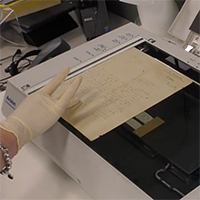The Xu Dishan Collection » About the Xu Dishan Collection
About the Xu Dishan Collection
Biography of Xu Dishan
Xu Dishan 許地山 (1893-1941) is known as an outstanding writer of short stories and novellas. He received his education in China, the US and the UK, and became an important scholar in religious studies and social anthropology, new research topics at the time at Chinese universities. His teachings and research focused on Buddhism, Daoism, Sanskrit, anthropology, and history of religion. After working at Beijing University, and Yenching University he became Professor of Chinese Studies at the University of Hong Kong. There he reorganised the Studies of Chinese and also became famous as an educator and reformer. His knowledge of several languages enabled him to translate some of Tagore’s works and Christian religious texts into Chinese. Xu Dishan’s works in literature, religious studies, and the studies of folklorist beliefs are milestones in Chinese literati culture and are still worked on today internationally.
Biography of C. P. Fitzgerald
Charles Patrick Fitzgerald (1902–1992), sinologist, was born Karl Patrick Van Hoogstraten on 5 March 1902 in London, the fourth child of South African-born Hans Sauer, medical doctor, and his Irish-born wife Cecile Josephine, née Fitzpatrick. His father, who did not practise medicine, was a financial assistant to Cecil Rhodes in South Africa and England. Patrick, as he was known, was educated at Clifton College, Bristol. Although he passed the entrance examination to the University of Oxford, his family could not afford the fees and he worked for a bank instead. He had become interested in East Asia at an early age. Intrigued by the short-lived restoration of the monarchy in Peking (Beijing) in 1917, he determined to go there and took classes towards a diploma in Chinese at the School of Oriental Studies, University of London. In 1923 he sailed for Shanghai.
The printing process
Many texts that Xu Dishan collected were printed from engraved woodblocks (xylography). This technology was available in China since the 7th century with the oldest surviving document, the title page of the Diamond Sutra, printed from a woodblock dating to 868 CE. Woodblock printing allowed distribution of high numbers of volumes, and, at that time of this oldest document, were used for Buddhist religious scripts. The continuous development and improvement of this technique later allowed prints of all kinds of materials: religious books, classical literature, illustrations in colour, every-day objects and documents, and folk literature. Various kinds of paper provided a comparatively cheap medium, and some literati are known to have possessed libraries with thousands of printed scrolls. Temples and private sponsors published and printed religious scripts, and privately founded printing enterprises rose, who would specialise in xylographic printing. Religious scripts could be printed from woodblocks carved centuries ago if the printing house had stored them. In many of these cases we do not have a reprint date, or a note from which blocks the print was made and must rely on other identification. Woodblock printing was the essential technique until the late 19th century.
The missionaries from the West encountered a well-established publishing and printing culture. In the 19th century when missionary work reached its height, missionaries brought lithographic printing with them to support the print and distribution of bibles. The high quality of lithographic printing, for illustrations and photographic reproductions, helped to establish increasingly professional, private printing enterprises. These were mostly set up by former missionary printing house employees. Newspapers, journals, books on science, and much more was printed in this way, and an era called “print capitalism” developed after 1900. It is possible that there are items in the Xu Dishan Collection that are lithographic prints, but they are yet to be identified.
Digitising the collection

In 2017 the Xu Dishan Collection was identified for digitisation owing to several convincing factors:
- The importance of the collection: The collection of eminent Professor Xu Dishan was the Australian National University Library’s first formed collection and once acquired, became the original core of the ANU Library’s Asia-Pacific collection.
- The strong interest: Researchers worldwide support and continue to require access to Xu Dishan’s studies, scholarship and literature. The international interest stems from the rarity of items within the collection and is amplified by institutional losses over the years.
- The fragile nature of the collection: Creating a need for preservation to ensure ongoing future access for research and scholarship.
Due to the fragile nature of the collection, digitisation was conducted in-house over several years, with the digitisation being completed in late 2019.
The frailty of the materials meant that careful consideration and handling techniques were utilised during the scanning process. Staff handling materials used gloves to ensure minimal ink transfer and products such as mylar were placed onto the surface of the books to reduce further tearing and wear on the pages. Once an item was scanned preservation measures were put in place to prevent further degradation.










